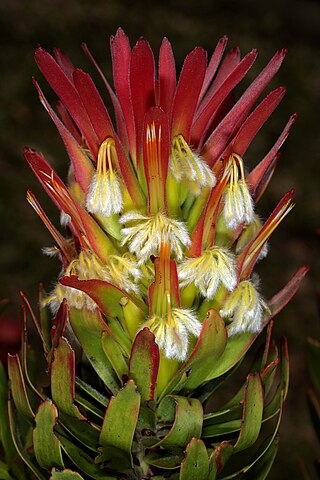
Mimetes, the pagoda, is a genus of evergreen shrubs or small trees 0.5–6 m (1.6–19.7 ft) high, with thirteen species assigned to the family Proteaceae. This genus, as with other proteas, is popular with nectarivorous birds such as the Cape sugarbird and several sunbird species. All species of Mimetes are endemic to the Cape Floristic Region of South Africa.

Disa bracteata, also known as the bract disa, leek orchid or the South African weed orchid is a species of orchid native to South Africa.
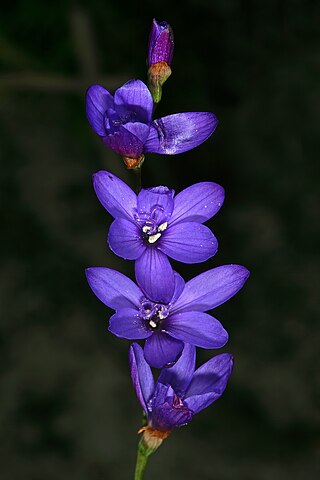
Geissorhiza aspera, also known as the blue satin flower or blou sysie, is a geophyte from South Africa.

Mimetes splendidus or splendid pagoda is an evergreen, rather sparsely branching, upright shrub of up to 2½ m (8 ft) high from the family Proteaceae. It has broadly lance-shaped to oval, silvery-hairy leaves with three or four teeth crowded at the tip. It has cylinder-shaped inflorescences that consists of many heads, each containing eleven to thirteen flowers, in the axils of the highest leaves. These leaves form a hood over a lower flowerhead and are flushed orangy pink. It flowers during winter, from early May to September. It is an endemic species that is restricted to the south face of the coastal mountains of the Western Cape province of South Africa.

Mimetes argenteus is an evergreen, upright, hardly branching, large shrub of about 2 m (6½ ft) high in the family Proteaceae. It has elliptic, silvery leaves, due to a dense covering of silky hairs, that stand out a right angle from the branches. It has cylindric inflorescences of 8–15 cm (3–6 in) long and 10–12 cm (4–5 in) in diameter, crested by smaller silvery pink leaves at an upright angle. These consist of many flower heads, each containing six to nine individual flowers and ar set in the axil of a leaf flushed mauve to carmine. It flowers from March to June. The silver pagoda naturally occurs in the Western Cape province of South Africa. It is called silver pagoda or silver-leaved bottlebrush in English and vaalstompie in Afrikaans.

Protea pudens, also known as the bashful sugarbush, is a low-growing, groundcover-like, flowering shrub in the genus Protea. It is only found growing in the wild in a small area in the Western Cape province of South Africa.
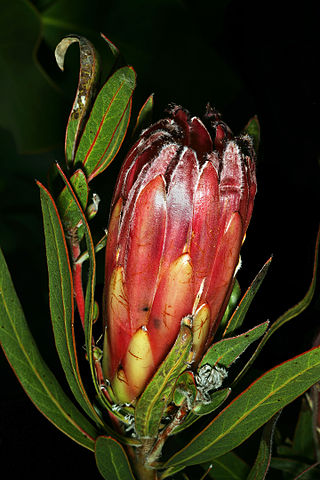
Protea burchellii, also known as Burchell's sugarbush, is a flowering shrub in the genus Protea, which is endemic to the southwestern Cape Region of South Africa.

Lobostemon is a genus of flowering plants belonging to the family Boraginaceae. It is endemic to the Cape Provinces of South Africa. The majority of species are limited to the winter rainfall area of the country, from Springbok to Mossel Bay. In Afrikaans these species are known as agtdaegeneesbos, or loosely translated, bush that will heal in eight days. As this name suggests, many species have medicinal properties. This is best known from Lobostemon fruticosus, which is used for treating wounds, blood poisoning, ringworm, skin diseases and syphilis.

Lobostemon montanus, the turquoise bush bugloss, mountain lobostemon or agtdaegeneesbos, is a South African species belonging to the forget-me-not family.

Lobostemon belliformis, the Gouriqua lobostemon or beaut healthbush, is a critically endangered species in the forget-me-not family. It is known from a single locality on the Riversdale Plain in South Africa.

Lobostemon capitatus is a species belonging to the forget-me-not family. It is endemic to the Western Cape of South Africa, where it is found between Porterville and Bredasdorp.
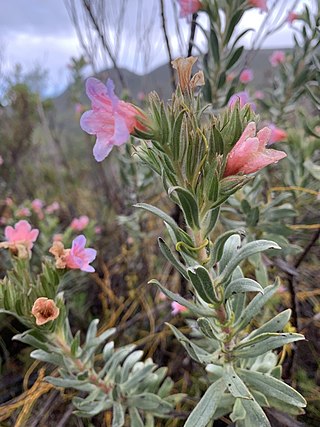
Lobostemon curvifolius, the largeflower healthbush, is a species of the forget-me-not family from South Africa.
Lobostemon collinus, the pyjamabush or iron healthbush, is a species belonging to the forget me not family. It is known only from the fynbos biome of the Western Cape of South Africa.
Lobostemon daltonii, the Infanta healthbush, is a species of the forget-me-not family endemic to the Cape Provinces of South Africa.
Lobostemon decorus, the Rooiberg healthbush, is a species belonging to the forget-me-not family. It is endemic to the Western Cape of South Africa.
Lobostemon echioides, the common healthbush, is the mostly widely distributed species in its genus. It is endemic to the Cape Provinces of South Africa, where it is found growing between Namaqualand and the Karoo and the Eastern Cape.
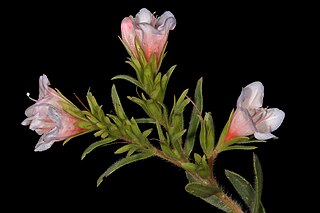
Lobostemon fruticosus, also known as the eightday healthbush or pyjamabush, is a species of medicinal plant endemic to the Cape Provinces of South Africa. It is considered to be ecologically and economically important but is declining due to overexploitation.
Lobostemon glaber, the renoster healthbush, is a species of plant from South Africa. It is in the forget-me not family.
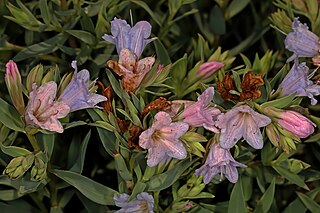
Lobostemon glaucophyllus, the smooth-leaved bush bugloss or grey healthbush, is a South African plant species belonging to the forget-me-not family. It is endemic to South Africa's Cape Provinces.
Senecio ruwenzoriensis is an African species of plant. While it is widely distributed, it seems to be highly localised in this range.














